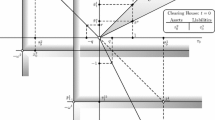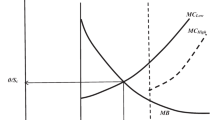Abstract
This article analyzes mortgage-market equilibrium when borrower default costs are private information. By applying the approach of Rothschild and Stiglitz (1976), it is shown that asymmetric information regarding default costs distorts the contract choices available in the mortgage market, preventing safe borrowers (those with high default costs) from fully satisfying their demand for mortgage debt. Large loans are available for a substantial interest-rate premium, but only risky borrowers find this premium worth paying. The article builds on an empirical literature designed to test the ruthless-default principle from option-based models of mortgage pricing. That literature provides evidence against ruthless behavior, suggesting that default costs play an important role in borrower decisions. The article takes a further step by arguing that such costs are private information, which has important implications for market equilibrium.
Similar content being viewed by others
References
Barth, J. R., J. J. Cordes, and A. M. J. Yezer. (1980). “Financial Institution Regulations, Redlining, and Mortgage Markets,” In The Regulation of Financial Institutions, Conference Vol. 21 (pp. 101-143). Boston: Federal Reserve Bank of Boston.
Berkovec, J., G. B. Canner, T. Hannan, and S. A. Gabriel. (1994). “Race, Redlining and Residential Mortgage Loan Performance,” Journal of Real Estate Finance and Economics 9, 263-294.
Brueckner, J. K. (1994a). “Borrower Mobility, Adverse Selection, and Mortgage Points,” Journal of Financial Intermediation 3, 416-441.
Brueckner, J. K. (1994b). “Unobservable Default Propensities, Optimal Leverage, and Empirical Default Models,” Journal of Real Estate Finance and Economics 9, 217-222.
Capozza, D. R., D. Kazarian, and T. A. Thomson. (1997). “Mortgage Default in Local Markets,” Real Estate Economics 25, 631-655.
Buser, S. A., and P. H. Hendershott. (1984). “Pricing Default-Free Mortgages,” Housing Finance Review 3, 405-429.
Campbell, T. S., and J. K. Dietrich. (1983). “The Determinants of Default on Conventional Residential Mortgage Loans,” Journal of Finance 38, 1569-1579.
Chari, V. V., and R. Jagannathan. (1989). “Adverse Selection in a Model of Real Estate Lending,” Journal of Finance 44, 499-508.
Cunningham, D. F., and P. H. Hendershott. (1984). “The Pricing of FHA Mortgage Default Insurance,” Housing Finance Review 3, 373-392.
Dunn, K. B., and J. J. McConnell. (1981). “Valuation of GNMA Mortgage-Backed Securities,” Journal of Finance 36, 599-616.
Dunn, K. B., and C. S. Spatt. (1985). “An Analysis of Mortgage Contracting: Prepayment Penalties and the Dueon-Sale Clause,” Journal of Finance 40, 293-308.
Dunn, K. B., and C. S. Spatt. (1988). “Private Information and Incentives: Implications for Mortgage Contract Terms and Pricing,” Journal of Real Estate Finance and Economics 1, 47-60.
Epperson, J. F., J. B. Kau, D. C. Keenan, and W. J. Muller III. (1985). “Pricing Default Risk in Mortgages,” Journal of the American Real Estate and Urban Economics Association 13, 261-272.
Foster, C., and R. Van Order. (1984). “An Option-Based Model of Mortgage Default,” Housing Finance Review 3, 351-377.
Foster, C., and R. Van Order. (1985). “FHATerminations: A Prelude to Rational Mortgage Pricing,” Journal of the American Real Estate and Urban Economics Association 13, 273-291.
Hendershott, P. H., and W. R. Schultz. (1993). “Equity and Nonequity Determinants of FHA Single-Family Mortgage Foreclosures in the 1980s,” Journal of the American Real Estate and Urban Economics Association 21, 405-430.
Kau, J. B., D. C. Keenan, W. J. Muller III, and J. F. Epperson. (1992). “A Generalized Valuation Model for Fixed-Rate Residential Mortgages,” Journal of Money, Credit and Banking 24, 279-299.
Kau, J. B., D. C. Keenan, and T. Kim. (1993). “Transaction Cost, Suboptimal Termination and Default Probabilities,” Journal of the American Real Estate and Urban Economics Association 21, 247-263.
Kau, J. B., D. C. Keenan, and T. Kim. (1994). “Default Probabilities for Mortgages,” Journal of Urban Economics 35, 278-296.
Kau, J. B., D. C. Keenan, W. J. Muller III, and J. F. Epperson. (1995). “The Valuation and Origination of Fixed-Rate Mortgages with Default and Prepayment,” Journal of Real Estate Finance and Economics 11, 5-36.
Lekkas, V., J. M. Quigley, and R. Van Order. (1993). “Loan Loss Severity and Optimal Mortgage Default,” Journal of the American Real Estate and Urban Economics Association 21, 353-371.
LeRoy, S. F. (1996). “Mortgage Valuation under Optimal Prepayment,” Review of Financial Studies 9, 817-844.
Posey, L. L., and A. Yavas. (1997). “Adjustable and Fixed Rate Mortgages as a Screening Mechanism for Default Risk.” Journal of Urban Economics, forthcoming.
Quigley, J. M., and R. Van Order. (1990). “Effciency in the Mortgage Market: The Borrower's Perspective,” Journal of the American Real Estate and Urban Economics Association 18, 237-252.
Quigley, J. M., and R. Van Order. (1995). “Explicit Tests of Contingent Claim Models of Mortgage Default,” Journal of Real Estate Finance and Economics 11, 99-117.
Riddiough, T., and H. E. Thompson. (1993). “Commercial Mortgage Pricing and Unobservable Borrower Default Costs,” Journal of the American Real Estate and Urban Economics Association 21, 265-291.
Rothschild, M., and J. E. Stiglitz. (1976). “Equilibrium in Competitive Insurance Markets: An Essay in the Economics of Imperfect Information,” Quarterly Journal of Economics 80, 629-649.
Stanton, R., and N. Wallace. (1997). “Mortgage Choice: What's the Point.” Real Estate Economics, 26, 173-205.
Stiglitz, J. E., and A. Weiss. (1981). “Credit Rationing in Markets with Imperfect Information,” American Economic Review 71, 393-410.
Titman, S., and W. N. Torous. (1989). “Valuing Commercial Mortgages: An Empirical Evaluation of the Contingent-Claims Approach to Pricing Risky Debt,” Journal of Finance 44, 345-373.
Vandell, K. D., and T. Thibodeau. (1985). “Estimation of Mortgage Defaults Using Disaggregate Loan History Data,” Journal of the American Real Estate and Urban Economics Association 13, 292-316.
Yang, T. L. T. (1992). “Self-Selection in the Fixed-Rate Mortgage Market,” Journal of the American Real Estate and Urban Economics Association 20, 359-391.
Yezer, A. M. J., R. F. Phillips, and R. P. Trost. (1994). “Bias in Estimates of Discrimination and Default in Mortgage Lending: The Effects of Simultaneity and Self-Selection,” Journal of Real Estate Finance and Economics 9, 197-215.
Author information
Authors and Affiliations
Rights and permissions
About this article
Cite this article
Brueckner, J.K. Mortgage Default with Asymmetric Information. The Journal of Real Estate Finance and Economics 20, 251–274 (2000). https://doi.org/10.1023/A:1007885109086
Issue Date:
DOI: https://doi.org/10.1023/A:1007885109086




